Related Research Articles
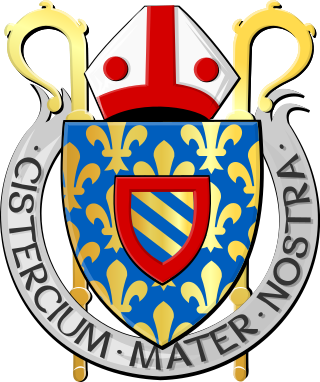
The Cistercians, officially the Order of Cistercians, are a Catholic religious order of monks and nuns that branched off from the Benedictines and follow the Rule of Saint Benedict, as well as the contributions of the highly-influential Bernard of Clairvaux, known as the Latin Rule. They are also known as Bernardines, after Saint Bernard himself, or as White Monks, in reference to the colour of the "cuculla" or cowl worn by the Cistercians over their habits, as opposed to the black cowl worn by Benedictines.

Fountains Abbey is one of the largest and best preserved ruined Cistercian monasteries in England. It is located approximately 3 miles (5 km) south-west of Ripon in North Yorkshire, near to the village of Aldfield. Founded in 1132, the abbey operated for 407 years, becoming one of the wealthiest monasteries in England until its dissolution, by order of Henry VIII, in 1539.
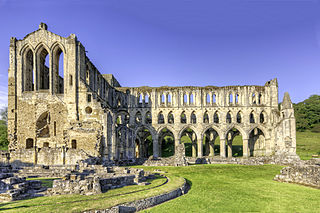
Rievaulx Abbey was a Cistercian abbey in Rievaulx, near Helmsley, in the North York Moors National Park, North Yorkshire, England. It was one of the great abbeys in England until it was seized in 1538 under Henry VIII during the Dissolution of the Monasteries. The wider site was awarded Scheduled Ancient Monument status in 1915 and the abbey was brought into the care of the then Ministry of Works in 1917. The ruins of its main buildings are today a tourist attraction, owned and maintained by English Heritage.
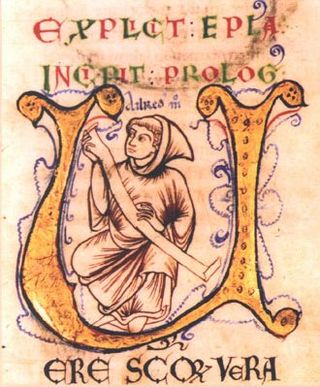
Aelred of Rievaulx, O Cist. ; also Ailred, Ælred, and Æthelred; was an English Cistercian monk, abbot of Rievaulx from 1147 until his death, and known as a writer. He is regarded by Anglicans and Catholics as a saint.
Waltheof was a 12th-century English abbot and saint. He was the son of Simon I of St Liz, 1st Earl of Northampton and Maud, 2nd Countess of Huntingdon, thus stepson to David I of Scotland, and the grandson of Waltheof, Earl of Northampton.

St Mary's Abbey, Melrose is a partly ruined monastery of the Cistercian order in Melrose, Roxburghshire, in the Scottish Borders. It was founded in 1136 by Cistercian monks at the request of King David I of Scotland and was the chief house of that order in the country until the Reformation. It was headed by the abbot or commendator of Melrose. Today the abbey is maintained by Historic Environment Scotland as a scheduled monument.
Henry Murdac was abbot of Fountains Abbey and Archbishop of York in medieval England.
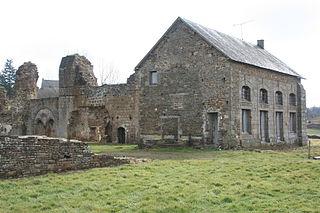
The monastic Congregation of Savigny started in the abbey of Savigny, situated in northern France, on the confines of Normandy and Brittany, in the Diocese of Coutances. It originated in 1105 when Vitalis of Mortain established a hermitage in the forest at Savigny in France.
The Abbot of Rievaulx was the head of the Cistercian monastic community of Rievaulx Abbey, founded in 1131 by Walter l'Espec in North Yorkshire, northern England. The Abbots of Rievaulx were amongst the most powerful Christian leaders in northern England until the dissolution of the monastery by Henry VIII of England in 1538.

The Abbot and then Commendator of Melrose was the head of the monastic community of Melrose Abbey, in Melrose in the Borders region of Scotland. The abbots of the earlier Northumbrian foundation from Lindisfarne are not included here. The second abbey was founded in 1136 on the patronage of David I, King of Scots, by Cistercian monks from Rievaulx Abbey, Yorkshire. Control of the abbey was secularized in the 16th century and after the accession of James Stewart, the abbey was held by commendators. The last commendator, James Douglas of Lochleven, resigned the abbacy to William Douglas, 6th Earl of Morton in December 1606, and the abbey itself to the king in 1608. The abbey was then erected into a secular lordship for viscount Haddington, John Ramsay, who in 1609 was created "Lord Melrose". Lochleven however resumed the title of commendator in 1613 until his death in 1620.

Robert of Newminster was a priest, abbot, and a saint of the Catholic Church. He was born in Gargrave in Yorkshire, England. He was one of the monks who founded Fountains Abbey and is named from the abbey he founded in Morpeth, Northumberland.

Whitland Abbey was a country house and Cistercian abbey in the parish of Llangan, in what was the hundred of Narberth, Carmarthenshire, Wales. The town which grew up nearby is now named Whitland after it. It was widely known as Ty Gwyn ar Daf, meaning White House on the Taf, in reference to the country house originally built here before it became a monastic settlement which was known under that name. It is most associated with being the place where Hywel Dda drew up his laws around 940. It functioned as a Cistercian monastery between the 12th and 16th centuries.
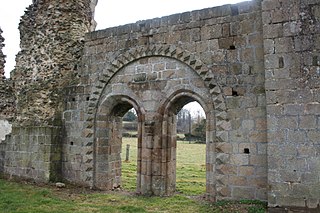
Savigny Abbey was a monastery near the village of Savigny-le-Vieux (Manche), in northern France. It was founded early in the 12th century. Initially it was the central house of the Congregation of Savigny, who were Benedictines; by 1150 it was Cistercian.

La Trappe Abbey, also known as La Grande Trappe, is a monastery in Soligny-la-Trappe, Orne, France. It is known for being the house of origin of the Trappists, to whom it gave its name.
Events from the 1130s in England.
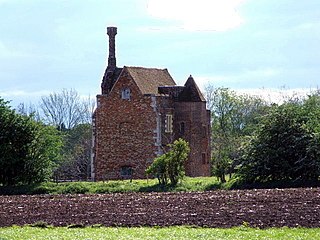
Wardon or Warden Abbey, Bedfordshire, was one of the senior Cistercian houses of England, founded about 1135 from Rievaulx Abbey. It is a Grade I listed building.

Sibton Abbey, an early Cistercian abbey located near Yoxford, Suffolk, was founded about 1150 by William de Chesney, High Sheriff of Norfolk and Suffolk. A sister house of Warden Abbey, near Bedford, Bedfordshire, Sibton Abbey was the only Cistercian abbey in East Anglia. It was dissolved in 1536.
Eustace fitz John, Constable of Chester, was a powerful magnate in northern England during the reigns of Henry I, Stephen and Henry II. From a relatively humble background in South East England, Eustace made his career serving Henry I, and was elevated by the king through marriage and office into one of the most important figures in the north of England. Eustace acquired a great deal of property in the region, controlled Bamburgh Castle, and served jointly with Walter Espec as justiciar of the North.
Richard was an English Benedictine and Cistercian, the first abbot of Fountains.
Stephen of Sawley, also known as Stephen of Easton, was a Cistercian monk, born in Eston, Yorkshire in the late twelfth century.
References
- Notes
- 1 2 3 4 5 6 7 8 9 10 11 Coppack, Glyn (2009). Fountains Abbey. Amberley. ISBN 978 1 84868 418 8.
- ↑ The Howard family, Dukes of Norfolk, were granted Sibton Abbey by the Crown at the dissolution of the monasteries. Sibton Abbey and Sibton Manor were subsequently sold in 1610 to Ralph Scrivener, barrister of Ipswich. The Abbey is in ruins, but the refectory and the south wall of the nave survive, although the ruins are heavily overgrown. The Scrivener family (Levett-Scrivener) continues to reside there.
- ↑ Sibton Abbey Account Book, Saxmundham, Private collection of J. E. Levett-Scrivener, Digital Archive of Medieval Music
- Sources
- Glyn Coppack: The White Monks ISBN 0-7524-1493-3